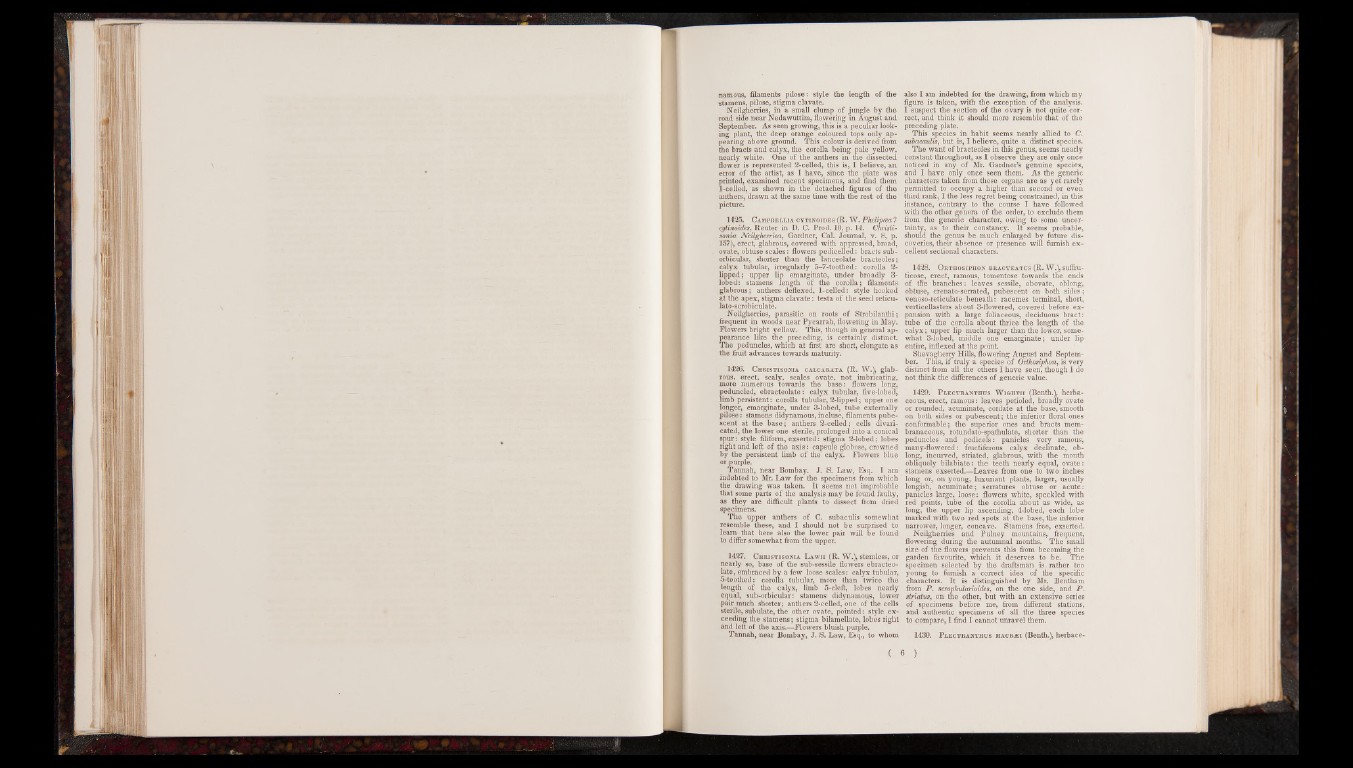
namous, filaments pilose: style the length of the
stamens, pilose, stigma clavate.
Neilgherries, in a small clump of jungle by the
road side near Nedawuttim, flowering in August and
September. As seen growing, this is a peculiar looking
plant, the deep orange coloured tops only appearing
above ground. This colour is derived from
the bracts and calyx, the corolla being pale yellow,
nearly white. One of the anthers in the dissected
flower is represented 2-celled, this is, I believe, an
error of the artist, as I have, since the plate was
printed, examined recent specimens, and find them
1-celled, as shown in the detached figures of the
anthers, drawn at the same time with the rest of the
picture.
1425. Campbellia cytinoides (R. W . Pheliptea ?
cytinoides, Reuter in D. C. Prod. 10, p. 14. Christi-
sonia JVeilgherriea, Gardner, Cal. Journal, v. 8, p.
157), erect, glabrous, covered with appressed, broad,
ovate, obtuse scales: flowers pedicelled: bracts sub-
orbicular, shorter than the lanceolate bracteoles;
calyx tubular, irregularly 5-7-toothed: corolla 2-
lipped; upper lip emarginate, under broadly 3-
lobed: stamens length of the corolla; filaments
glabrous; anthers deflexed, 1-celled: style hooked
at the apex, stigma clavate: testa of the seed reticu-
lato-scrobiculate.
Neilgherries, parasitic on roots of Strobilanthi;
frequent in woods near Pycarrah, flowering in May.
Flowers bright yellow. This, though in general appearance
like the preceding, is certainly distinct.
The peduncles, which at first are short, elongate as
the fruit advances towards maturity.
1426. Christisonia calcarata (R. W.), glabrous,
erect, scaly, scales ovate, not imbricating,
more numerous towards the base: flowers long,
peduncled, ebracteolate: calyx tubular, five-lobed,
limb persistent: corolla tubular, 2-lipped; upper one
longer, emarginate, under 3-lobed, tube externally
pilose: stamens didynamous, incluse, filaments pubescent
at the base; anthers 2-celled; cells divaricated,
the lower one sterile, prolonged into a conical
spur: style filiform, exserted: stigma 2-lobed; lobes
right and left of the axis: capsule globose, crowned
by the persistent limb of the calyx. Flowers blue
or purple.
, Tannah, near Bombay. J. S. Law, Esq. I am
indebted to Mr. Law for the specimens from which
the drawing was taken. It seems not improbable
that some parts of the analysis may be found faulty,
as they are difficult plants to dissect from dried
specimens.
The upper anthers of C. subaculis somewhat
resemble these, and I should not be surprised to
learn that here also the lower pair will be found
to differ somewhat from the upper.
1427. Christisonia Lawxi (R. W.), stemless, or
nearly so, base of the sub-sessile flowers ebracteolate,
embraced by a few loose scales: calyx tubular,
5-toothed: corolla tubular, more than twice the
length of the calyx, limb 5-cleft, lobes nearly
equal, sub-orbicular: stamens didynamous, lower
pair much shorter; anthers 2-celled, one of the cells
sterile, subulate, the other ovate, pointed: style exceeding
the stamens; stigma bilamellate, lobes right
and left of the axis.—Flowers bluish purple.
Tannah, near Bombay, J. S. Law, Esq., to whom
also I am indebted for the drawing, from which my
figure is taken, with the exception of the analysis.
I suspect the section of the ovary is not quite correct,
and think it should more resemble that of the
preceding plate.
This species in habit seems nearly allied to C.
subacaulis, but is, I believe, quite a distinct species.
The want of bracteoles in this genus, seems nearly
constant throughout, as I observe they are only once
noticed in any of Mr. Gardner’s genuine species,
and I have only once seen them. As the generic
characters taken from these organs are as yet rarely
permitted to occupy a higher than second or even
third rank, I the less regret being constrained, in this
instance, contrary to the course I have followed
with the other genera of the order, to exclude them
from the generic character, owing to some uncertainty,
as to their constancy. It seems probable,
should the genus be much enlarged by future discoveries,
their absence or presence will furnish excellent
sectional characters.
1428. Orthosiphon bracteatus (R. W.), suffru-
ticose, erect, ramous, tomentose towards the ends
of the branches: leaves sessile, obovate, oblong,
obtuse, crenato-serrated, pubescent on both sides;
venoso-reticulate beneath: racemes terminal, short,
verticellasters about 3-flowered, covered before expansion
with a large foliaceous, deciduous bract:
tube of the corolla about thrice the length of the
calyx; upper lip much larger than the lower, somewhat
3-lobed, middle one emarginate; under lip
entire, inflexed at the point.
Shevagherry Hills, flowering August and September.
This, if truly a species of Orthosiphon, is very
distinct from all tne others I have seen, though I do
not think the differences of generic value.
1429. Plectranthus W ightii (Benth.), herbaceous,
erect, ramous: leaves petioled, broadly ovate
or rounded, acuminate, cordate at the base, smooth
on both sides or pubescent; the inferior floral ones
conformable; the superior ones and bracts membranaceous,
rotundato-spathulate, shorter than the
peduncles and pedicels: panicles very ramous,
many-flowered: fructiferous calyx declinate, oblong,
incurved, striated, glabrous, with the mouth
obliquely bilabiate: the teeth nearly equal, ovate:
stamens exserted.—Leaves from one to two inches
long or, on young, luxuriant plants, larger, usually
longish, acuminate; serratures obtuse or acute:
panicles large, loose: flowers white, speckled with
red points, tube of the corolla about as wide, as
long, the upper lip ascending, 4-lobed, each lobe
marked with two red spots at the base, the inferior
narrower, longer, concave. Stamens free, exserted.
Neilgherries and Pulney mountains, frequent,
flowering during the autumnal months. The small
size of the flowers prevents this from becoming the
garden favourite, which it deserves to be. The
specimen selected by the draftsman is.rather too
young to furnish a correct idea of the specific
characters. It is distinguished by Mr. Bentham
from P . scrophularioides, on the one side, and P .
striatus, on tne other, but with an extensive series
of specimen's before me, from different stations,
and authentic specimens of all the three species
to compare, I find I cannot unravel them.
1430. Px.ectranthus MACRiEi (Benth.), herbace